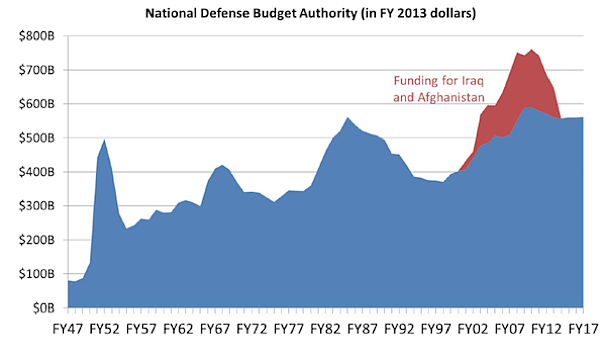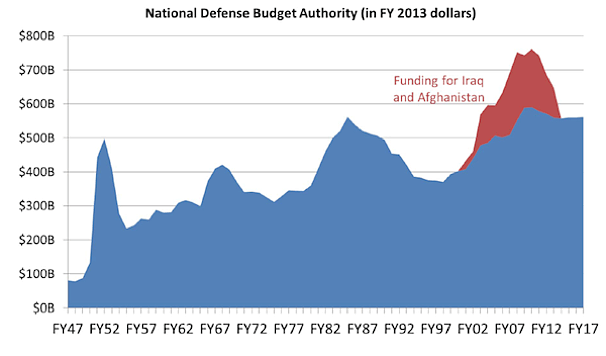
Part of the Series
Solutions
If you are a regular Truthout reader, you probably know this in your gut. However, take the time to look at this chart, examine it carefully and internalize what it means.
 (Source: Time Magazine)
(Source: Time Magazine)
Take a close look at the peaks and see that the first one is the Korean War, the second one is the Vietnam War, the third one is the peak of the long cold war and the final blue peak is … no, it isn’t the Iraq and Afghanistan wars, it is what our defense budget grew to because of our national fear after 9/11 … the cost of these two wars is the looming giant red peak, above and beyond our post-9/11 frenzy. Notice that each one of these last peaks is higher than the height of the cold war, when we were building a nuclear arsenal and all types of cold war planes, ships and tanks to defeat the Soviet Union if they invaded Europe.
 (Image: Jared Rodriguez / Truthout)There are two other things to consider about this chart. Remember, this chart does not reflect monetary inflation; these numbers are in constant FY 2013, so you can’t complain about how inflation makes everything cost more. Second, look at the valleys when the wars ended; each time, they are higher than the last valley, showing an entrenched and institutional rise after each war. War or no war, this budget just keeps growing in real terms, despite the rise and fall of threats, despite what the rest of the world was spending on defense, despite other areas of need in our country like infrastructure and education and despite our burgeoning federal debt.
(Image: Jared Rodriguez / Truthout)There are two other things to consider about this chart. Remember, this chart does not reflect monetary inflation; these numbers are in constant FY 2013, so you can’t complain about how inflation makes everything cost more. Second, look at the valleys when the wars ended; each time, they are higher than the last valley, showing an entrenched and institutional rise after each war. War or no war, this budget just keeps growing in real terms, despite the rise and fall of threats, despite what the rest of the world was spending on defense, despite other areas of need in our country like infrastructure and education and despite our burgeoning federal debt.
The defenders and beneficiaries of this endlessly rising budget are already squealing about a planned cut in the increase of the defense budget. But added on to that is the sequestration deal that both political parties made to cut social programs and defense, with each side not really believing that the other side will go through with it. Despite the wails of concern from even his own defense secretary, Obama said that he plans to go through with cutting over $500 billion from defense over a decade if no other deal is made. The Republicans and some hawk Democrats have screamed, threatened and rended their garments over this possibility that will bring the defense budget back to 2006 levels.
 Now, go back and look at the chart again. You can see that former President George W. Bush made sure that the Department of Defense’s (DoD) budget was very healthy that year – see how that level of spending is near the level of the height of the cold war, and that is not counting the hot wars in Iraq and Afghanistan. What was good enough to supposedly protect our country when Bush was president is presented as a tragedy if President Obama wants to slow the growth to that level.
Now, go back and look at the chart again. You can see that former President George W. Bush made sure that the Department of Defense’s (DoD) budget was very healthy that year – see how that level of spending is near the level of the height of the cold war, and that is not counting the hot wars in Iraq and Afghanistan. What was good enough to supposedly protect our country when Bush was president is presented as a tragedy if President Obama wants to slow the growth to that level.
However, even without any cuts or slowing of growth, the defense budget is not high enough for presidential candidate Mitt Romney, who wants the defense budget to grow to 4 percent of our Gross Domestic Product (GDP). According to Businessweek:
The problem with tying defense spending to economic performance is that GDP fluctuations don’t always line up with changes in threats or military requirements. If the economy is weak and threats are high, more spending might be justified. The opposite – a strong economy in relative peacetime – could also be true.
Romney estimates that under his policies GDP will grow by about 4 percent a year, a rate somewhat lower than many forecasts. Still, if the economy grows as he predicts and he gradually ramps up defense spending to his goal of 4 percent of GDP by the end of his first term, the nation would spend about $400 billion more on defense in Romney’s first term than Obama currently plans in his second.
Businessweek wondered how Mr. Romney could spend all that extra defense money, but I am sure that the defense contractors, if that type of funding would pass, will dust off all their gee-whiz, but out-of-date, weapons that will obligate us for trillions of dollars in the future while not making us more safe.
I have written on how our defense industry has lobbied and bought our politicians for years with campaign contributions, jobs for top Pentagon military and civilian staff and pork jobs for states and Congressional districts. I have written on my pet bugaboo on how our pricing of weapons has caused each new generation of weapons to have all the waste, fat and fraud built into their prices because the Pentagon uses historical pricing, i.e. price weapons based on what the past weapons cost. I wrote 39 Truthout columns last year on reforming the Pentagon that can be found in a Truthout reader electronic book. I have also written a book on the destructive practice of using contractors in the war zone, a trend that exploded during the Iraq and Afghanistan wars, and how that has built a war service industry that now needs a hot war or conflict to stay viable.
And, of course, I am not the only one who has dedicated a good portion of my professional life trying to expose the folly and tragedy of all this wasted spending and bloated budget. Many other journalists and pundits have spilled ink and electrons to warn of what this chart is showing us. So, the question is, why does the public keep going along with it?
I have seen times when they haven’t, as when, in the 1980s, I exposed ineffective and expensive weapons and especially hit a nerve with the public on overpriced spare parts like the $435 hammer and $7,600 coffee brewer. These exposés led to an unprecedented budget freeze for one year during the massive Reagan defense buildup. But, then, the line of the chart just kept going up, ballooning during war and then not dropping back down to the last post-war level each time.
Why is the public allowing this? I know the political manipulations that go on in Washington, and I have assumed that it was the constant warning of an scary enemy that made the public go along with the mindless spending that this chart shows. But I was never quite satisfied with that answer.
Rachel Maddow’s book, “Drift,” seeks to explain why this keeps happening. The title of the book says it all – that by getting rid of the draft and not asking the general public to make any sacrifices during war, the Pentagon and the politicians can keep us more and more on a wartime footing, which keeps the valleys in this chart growing higher and higher. Also, as we move further and further away from the original constitutional concept that the Congress is suppose to declare war and give that responsibility to the president, it is easier and less politically messy for the president to take us into war.
The public is just not feeling it unless you are a very small minority who has a child or a spouse actually in the military and serving in a war zone. The public has not directly felt the pain of paying for the wars because taxes have not been raised to pay for it and the nation’s credit card has not been paid. President George W. Bush made sure that the public’s nightly viewing of the news was not marred by visuals of coffins rolling in to Dover Air Force Base by greatly restricting press coverage of that and military funerals. The main public participation in “supporting the troops” was mainly putting a yellow ribbon magnet on your car.
Maddow starts with our founding fathers’ concerns with war and having a standing Army and builds the case through each war until she reaches our recent two wars as the most painless and obscure to the public. She lays out the state in which we finally find ourselves as a nation:
Our national security policy isn’t much related to its stated justifications anymore. To whatever extent we do argue and debate what defense and intelligence policy ought to be, that debate – our political process – doesn’t actually determine what we do. We’re not directing that policy anymore; it just follows its own course. Which means we’ve effectively lost control of a big part of who we are as a country. And we’ve broken faith with some of the best advice the founders ever given us.
She goes on to explain many other ways in which we, as a nation have drifted into the problems that the chart illustrates and how much we have drifted from our constitutional restraints on defense. She quotes a comment a senior defense official told her about getting ever-increasing money from the Congress, another one of their constitutional duties: “‘We don’t have any enemies in Congress,’ a senior defense official told me in 2011. ‘We have to fight Congress to cut programs, not keep them.'”
Maddow lays out several solutions at the end of the book, saying that this condition is fixable and they are wise, but hard to do. I urge you, if you are sickened by this chart, to read the reforms and see how we could try to begin to implement them and change the flow of this chart and our drift toward endless war. Or as she said, “We just need to revive that old idea of America as a deliberately peaceable nation. That’s not simply our inheritance, it’s our responsibility.”
I agree with her and I know how hard it is to get the public to feel the pain of what we are doing as it is reflected in this chart. So, read this chart; internalize it; and, most importantly, pass it on, even to your Democratic, Independent and Republican friends and relatives. If you need more inspiration, read this quote from one of our founding fathers (by the way, isn’t it totally ironic how the conservative base insists that we go back to the principles of our founding fathers, but reject their advice on war?) that Maddow places at the beginning of her book:
Of all the enemies to public liberty, war is, perhaps, the most to be dreaded, because it comprises and develops the germ of every other. War is the parent of armies; from these proceed debts and taxes; and armies and debts and taxes are the known instruments for bringing the many under the domination of the few. In war, too, the discretionary power of the Executive is extended; its influence in dealing out offices, honors and emoluments is multiplied; and all the means of seducing the minds are added to those of subduing the force of the people. The same malignant aspect in republicanism may be traced in the inequality of fortunes and the opportunities of fraud growing out of a state of war and in the degeneracy of manners and morals engendered by both. No nation could reserve its freedom in the midst of continual warfare.
Those truths are well established. They are read in every page which records the progression from a less arbitrary to more arbitrary government, or the transition from a popular government to an aristocracy or a monarchy. [James Madison, “Political Observations” April 20, 1795.]
What would Madison think about this chart?
24 Hours Left: All gifts to Truthout now matched!
From now until the end of the year, all donations to Truthout will be matched dollar for dollar up to $22,000! Thanks to a generous supporter, your one-time gift today will be matched immediately. As well, your monthly donation will be matched for the whole first year, doubling your impact.
We have just 24 hours left to raise $22,000 and receive the full match.
This matching gift comes at a critical time. As Trump attempts to silence dissenting voices and oppositional nonprofits, reader support is our best defense against the right-wing agenda.
Help Truthout confront Trump’s fascism in 2026, and have your donation matched now!